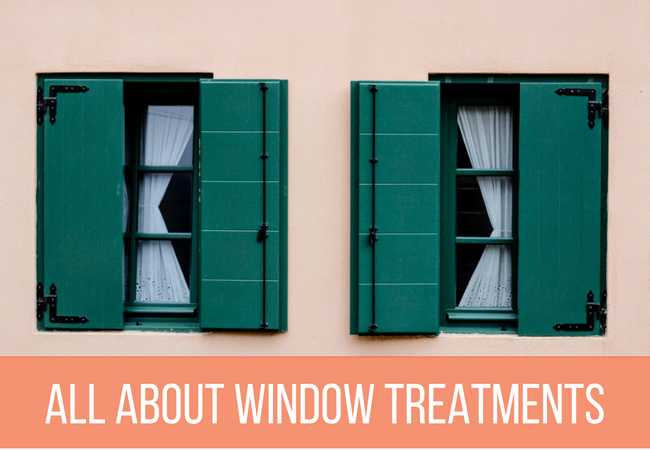all about window treatments
Photo by Sergiu Vălenaș on Unsplash edited in Canva
I’m going to be honest (when am I not?): when it comes to window treatments, the amount I know could fit in a thimble. It’s possible that I know just a tiny little bit more than the average bear, but that’s where it stops. I can identify your basic types of pleats in drapes, and if pressed, could probably explain the difference between a few types of valances. I know that silk isn’t a great option for windows because it disintegrates with sun exposure (this is why you will always see silk drapes with solid liners) and I know that UV film is an excellent idea for windows that get a lot of sun because they protect your furniture without changing the view. After that, I’m pretty much out. My lack of knowledge in this area is mostly because I love an open window and I hate fussy so it doesn’t even occur to me to add window treatments. This statement is full sacrilege in decorator world. Window treatments, like hardware, finish the room. Everyone knows that.
So it is that I found myself trying to find appropriate window treatments for our Modern Southern Bungalow over the last couple of weeks, first in Houston, and then in New York City. So it is that I also found myself feeling quite awkward working with window treatment specialists who I’m sure thought I should know more about window treatments than I do. In this process, I’ve learned a few things and have been reminded of a few things that might be helpful to you should you be looking for window treatments. Let’s start with the obvious…
Types of Window Treatments
We are going to stick with the very basics here. You already know the general categories of window treatments: curtains (we fancy decorator types call these “draperies” – don’t ask me why), shades, blinds, shutters, and valances. Within these categories fall multiple – at times overwhelming – subcategories.
Curtains are readily available in standard sizes and varying price points, and because you will find with a quick Google search more information than you ever needed to know as to how to select and hang curtains, I’m not going to bore you with my thoughts on curtains.
We can dispense with valances almost as easily as we can curtains. Valances can be used to dress a window when no curtain or shade is necessary or can be used to cover the curtain/blind/shade fittings. There are as many types of valances as there are curtains. Forgive me if I offend, but if valances are what you are after, you are on the wrong website. Less is more here at Animal Cracker Studio, and valances as a general rule fall into the more is more category.
So we move on to shades and blinds. "Shade" and "blind" seem to be used interchangeably by most people. Generally, I think of shades as being something that rolls or folds from bottom to top or top to bottom. I think of blinds as being slats of wood that can be tilted to change the direction of light and can also be raised from bottom to top. Keep in mind, these definitions are not technical and I’ll probably receive a rash of corrections from window coverings specialists. We are operating in generalities here, ok?
Both shades and blinds can be used on their own or in conjunction with curtains or valances. The sheer number of types here can really be overwhelming. Let’s stick with the basics. Roller, cellular, and Roman are three very common types of shades (love these Roman shades with pom pom fringe). A roller shade might be used in conjunction with a curtain or valance. A Roman shade will typically be used on its own but is occasionally used with curtains. Blinds typically come in vinyl, wood, or faux wood. They are easy to maintain and have a relatively clean look.
Shutters are fixed to the side rather than top or bottom of the window, and open like a door. They can have multiple sections or various louver controls for large windows such that the tops can open while the bottoms remain closed. We typically think of shutters as being an outside window treatment that protect windows from storms (personal pet peeve: shutters hung outside that aren't in proportion to the window and thus couldn't possibly be functional), but they can also be used inside to beautiful effect.
What kind of window treatments should I choose?
When selecting window treatments, it is important to understand whether your window treatments will be purely decorative or serve a specific function. Are you looking to create total darkness? Privacy? Add texture to your room? Protect your furniture from harsh sun?
The answers to these questions will dictate what types of window treatments you should consider. For example, the advantage of a blind over a curtain or shade is that you can adjust light without losing privacy. This is also true of shutters. The advantage of a shade or curtain over a blind is that you can “black out” a room. Light will continue to seep in through blinds or shutters but not through black out curtains or shades. Shades and blinds can be motorized and both can be set up to smart devices that allow you to control light within your home when you are out. I’ve yet to see a motorized curtain or shutter, but I’m sure someone is working on it.
Finishes are another consideration when selecting window coverings. While curtains are always made of fabric, and shutters and blinds are typically made of wood (or faux wood), shades can be made of fabric or natural fiber. Consider what else is in the room in which you need window coverings. If the room is upholstery heavy (i.e., there is fabric everywhere), you may want to use a shutter or a natural fiber shade to add some texture to the room. If the room has a lot of wood furniture, you may want to consider a curtain or fabric roman shade to soften the hard edges of the wood.
Standard vs. Custom Window Treatments
Perhaps most important to many of you is the consideration of budget. You can spend very little on a set of curtains from IKEA or you can spend a small fortune on custom draperies made from an exclusive designer textile hand woven in the mountains of Peru. There is no wrong answer here. Your decision to go standard versus custom will ultimately turn on your budget and how flexible you are willing to be with what you hang in your windows.
Yes, you can order window treatments that are “standard sizes”, but I would be wildly surprised if any of these actually fit your windows. “Standard size” as applied to shades and blinds typically has to do with window width. You can have standard blinds cut down at many big box stores, but you may still end up with a window treatment that is too long for your window. (Of course, we’ve already discounted the conversation about curtains here, so I am mostly talking about shades and blinds, but various standard curtain lengths are available online and in big box stores. Curtain lengths are incredibly easy to change so if budget is a major consideration, curtains might be your best option.)
If you opt to go custom, one of the first things you’ll be asked by a decorator or window treatment expert is to identify your budget. There’s also that little devil time, which favors ready-made over custom. If you have the budget, want what you want, and are dead set on custom, get started early. You are looking at a lead time of anywhere from two weeks to more than three months depending on what you order, the seamstress schedule, etc.
It is hard to know your budget when you don’t know what things cost. How do you do your homework before that first meeting? Check out ready-made options similar to what you want (many chain retailers like Pottery Barn now carry roman shades in neutral fabrics, and natural, textural shades can be found at Home Depot or Lowes). You can also price out online custom options (Smith and Noble and The Shade Store are a good start). You can also search for fabric options and estimate yardage using your old friend Google. Cordless and automated shades and blinds will cost more than traditional corded blinds and shades but may be well worth the additional cost depending on your priorities. No cords in a kid's room? Yes, please.
An added benefit of custom window treatments is that the decorator or in-store specialist will come to measure your windows so that you have a precise fit. They will also advise on the best finish to meet your needs and install your window treatments. If you opt to go with ready-made window treatments, be sure to look carefully at measurement instructions online. Window treatments can be installed inset or outside of the window. This is typically just a matter of aesthetic preference, but installation can make a difference in window covering or window functionality (see footnote below). You will have more choice in valance (the non-frilly, covers all the mechanisms kind or the decorative kind) if you go custom, but either way, measure at least twice before ordering your window treatments. And – broken record time – always order a sample of the fabric or finish before ordering the window treatments themselves.
I could, of course, go on, but I’m sure you have somewhere to be today. I’m off to pick out shades for our bedrooms and hallway. Until next week…
P.S. A quick note on the importance of measuring correctly. When we first moved into our house, we decided on plantation shutters because (1) they aren’t curtains, (2) they seemed to fit the style of the house, and most importantly (3), we could let light in from the top of the shutters without anyone being able to see into the house from the street. Fresh as we were to city dwelling when we bought our house, this seemed like the right way to go. We had the professional installer come out and measure, ordered, and waited 12 weeks for the shutters to be delivered. Once installed, we found that the inset installation we had chosen made it impossible for us to open our double hung windows in the way that they were designed to be opened. We were not advised of this before ordering our custom shutters. The only solution was to order new shutters and install them outside of our windows. The moral of the story is to make sure that the decorator or dealer that you are working with knows what kind of windows you have, understands the sizing of your window casing, and knows what will and won’t work with your windows. You are going to spend a good amount of money on custom window treatments. Make sure you spend it with a professional.

